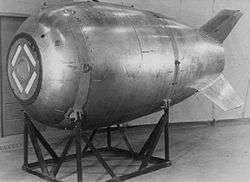Mark 4 nuclear bomb
| Mark 4 nuclear bomb | |
|---|---|
|
A Mark 4N aluminum bomb casing. Stockpile Mk 4's used a 2,830 lb. steel casing.[1] | |
| Type | Air-dropped Nuclear fission weapon |
| Place of origin | United States |
| Service history | |
| In service | 1949 - 1953 |
| Used by | United States Air Force (USAF) |
| Production history | |
| Number built | 550 |
| Specifications | |
| Weight | 10,800 to 10,900 pounds (4,900 to 4,940 kg) |
| Length | 128 in (3,300 mm) |
| Diameter | 60 in (1,500 mm) |
| Crew | 1x Weaponeer for pit insertion and arming |
|
| |
| Filling | Composite uranium and plutonium fissile pits |
Detonation mechanism | focussed high explosive implosion |
| Blast yield | 1, 3.5, 8, 14, 21, 22, 31 kt (4.2, 14.6, 33.5, 58.6, 87.9, 92.0, 129.7 TJ), depending on construction and/or pit |
The Mark 4 nuclear bomb was an American nuclear bomb design produced starting in 1949 and in use until 1953.
The Mark 4 was based on the earlier Mark 3 Fat Man design, used in the Trinity test and the bombing of Nagasaki. The Mark 3 was essentially handmade and constituted an emergency wartime expedient design; the Mark 4 utilized essentially the same basic principles (materials, dimensions of the nuclear core and explosive components) but reengineered the overarching system to be safer and easier to produce. The basic idea was to "GI-proof" otherwise sensitive nuclear weapons.
The Mark 4 was 60 inches (1.5 m) in diameter and 128 inches (3.3 m) long, the same basic dimensions as Mark 3. It weighed slightly more at 10,800 to 10,900 pounds (4,900 to 4,940 kg), depending on the specific Mark 4 version. (Mark 3 weighed 10,200 lb or 4,630 kg.)
In addition to being easier to manufacture, the Mark 4 introduced the concept of in flight insertion (IFI), a weapons safety concept which was used for a number of years. An IFI bomb has either manual or mechanical assembly, which keeps the nuclear core stored outside the bomb until close to the point that it may be dropped. To arm the bomb, the fissile nuclear materials are inserted into the bomb core through a removable segment of the explosive lens assembly, which is then replaced and the weapon closed and armed.
Mark 4 models used composite uranium and plutonium fissile pits. The exact pit assemblies were common with several other U.S. nuclear weapons, the Type C and Type D pit assemblies.
Along with being composite cores, the device was the first weapon to rely upon levitated-pit implosion. These early weapons with a levitated pit had a removable pit, called an open pit. It was stored separately, in a special capsule called a birdcage.[2] Various versions of the Mark 4 had explosive yields of 1, 3.5, 8, 14, 21, 22, and 31 kilotons (4 to 130 TJ).
A total of 550 Mark 4 nuclear weapons were produced. The Mark 4 was succeeded by the Mk6, which was generally similar but much improved.
W4 missile warhead
A variant called the W4 (Warhead 4), intended for use on the SM-62 Snark cruise missile, was designed but never built. The W4 design was cancelled in 1951.
See also
- 1950 British Columbia B-36 crash (a Mark 4 was on-board)
- List of nuclear weapons
- Mark 6 nuclear bomb
References
External links
- Allbombs.html list of all U.S. nuclear warheads at nuclearweaponarchive.org
